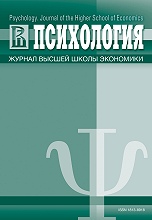Classification of Verbal and Mathematical Mental Operations Based on the Power Spectral Density of EEG
Abstract
A classification of spectral patterns of EEG underlies several cognitive neurotechnologies including passive and active brain-computer interfaces. Despite arithmetic tasks often being used in studies of cognitive workload, there is a lack of findings describing a possibility to recognize EEG patterns related to different types of math operations. In the present work, we have shown that the power spectral density of EEG can be used to classify types of mental operations including a classification of verbal and different mathematical tasks for simple arithmetic operations or logical tasks with arithmetic progressions. The verbal tasks were separated from arithmetic ones significantly better than arithmetic from logical tasks, and verbal from logical tasks. Better discrimination of verbal tasks from arithmetic but not from logical tasks supports the hypothesis of unique EEG patterns associated with verbal activity that apparently differ from mental operations in arithmetic. Additionally, we compared the behavioral performance in problem solving and accuracy of EEG classification in two groups of subjects with education in math or humanities (N=8+8). We obtained the predicted differences related to better performance of the math group in solving math tasks than the humanitarian group. However, the classification accuracy of tasks based on EEG did not differ significantly between groups and was essentially higher than random. Considered together, our results support the hypothesis that EEG patterns reflect individual cognitive states corresponding to mental operations and can be used in classification of different cognitive activity.
Downloads
References
2. Antonenko, P. D., & Niederhauser, D. S. (2010). The influence ofleads on cognitive load and learning in a hypertext environment. Computers in Human Behavior, 26, 140-150.
3. Antonenko, P., Paas, F., Grabner, R., & van Gog, T. ( 2010). Using electroencephalography to measure cognitive load. Educational Psychology Review, 22, 425-438.
4. Atanov, M. S., Ivanitsky, G. A., & Ivanitsky, A. M. (2016). Cognitive brain-Computer interface and probable aspects of its practical application. Human Physiology, 42(3), 235-240.
5. Chaouachi, M., Jraidi, I., & Frasson, C. (2011). Modeling mental workload using EEG features for intelligent systems, in J. A. Konstan et al. (Eds.), UMAP 2011: User Modeling, Adaption and Personalization(pp. 50-61). Berlin: Springer.
6. Chemerisova, E. V., & Martynova, O.,V. (2018, in press). Vliyanie fonologicheskoi petli rabochei pamyati na rezul’tativnost’ resheniya matematicheskikh i verbal’nykh zadach u matematikov i gumanitariev [Phonological loop of working memory affects performance of solving mathematical and verbal tasks in specialists of mathematics and humanities]. Zhurnal Vysshei Nervnoi Deyatelnosti imeni I. P. Pavlova. (in Russian)
7. Fairclough, S. H., Gilleade, K., Ewing, K. C., & Roberts, J. (2013). Capturing user engagement via psychophysiology: measures and mechanisms for biocybernetic adaptation. International Journal of Autonomous and Adaptive Communications Systems, 6(1), 63-79.
8. Fairclough, S. H., Venables, L., & Tattersall, A. (2005). The influence of task demand and learning on the psychophysiological response. International Journal of Psychophysiology, 56, 171-184.
9. Gerjets, P., Walter, C., Rosenstiel, W., Bogdan, M., & Zander, T. O. (2014). Cognitive state monitoring and the design of adaptive instruction in digital environments: lessons learned from cognitive workload assessment using a passive brain-computer interface approach. Frontiers in Neuroscience, 8, 385.
10. Hart, S. G., & Staveland, L. E. (1988). Development of NASA-TLX Results of empirical and theoretical research of human mental workload. Advances in Psychology, 52, 139-183.
11. Ivanitsky, G. A. (1997). Recognition of the task type in the process of its mental solving by a few-second eeg record using the learned classifier. Zhurnal Vysshei Nervnoi Deyatelnosti imeni I. P. Pavlova, 47(4), 743-747. (in Russian)
12. Jarvis, J. P., Putze, F., Heger, D., & Schultz, T. (2011). Multimodal person independent recognition of workload related biosignal patterns. In Proceedings of the 13th International Conference on Multimodal Interfaces, ICMI ‘11 (pp. 205-208). New York: ACM.
13. McCulloch, W. S., & Pitts, W. H. (1943). A logical calculus of the ideas immanent in nervous activity. Bulletin of Mathematical Boiphysics, 5, 115-133.
14. Pitts, W. H., & McCulloch, W. S. (1947). How we know universals. Bulletin of Mathematical Boiphysics, 5, 127-147.
15. Putze, F., & Schultz, T. (2014). Adaptive cognitive technical systems. Journal of Neuroscience Methods, 234, 108-115.
16. Tarotin, I. V., Atanov, M. S., & Ivanitsky, G. A. (2017). A model for human cognitive activity monitoring in real time (“Cognovtsor”). Zhurnal Vysshei Nervnoi Deyatelnosti imeni I. P. Pavlova, 67(4), 493-503. (in Russian)
17. Walter, C., Rosenstiel, W., Bogdan, M., Gerjets, P., & Spu ler, M. (2017). Online EEG-Based Workload Adaptation of an Arithmetic Learning Environment. Frontiers in Human Neuroscience, 11, 286.
18. Wang, Z., Hope, R. M., Wang, Z., Ji, Q., & Gray, W. D. ( 2012). Cross-subject workload classification with a hierarchical bayes model. NeuroImage, 59(1), 64-69.
19. Wilson, G. F., & Fisher, F. (1995). Cognitive task classification based upon topographic EEG data. Biological Psychology, 40(1-2), 239-250.
20. Zhu, F. F., Maxwell, J. P., Hu, Y., Zhang, Z. G., & Masters, R. S. W. (2010). EEG activity during the verbal-cognitive stage of motor skill acquisition. Biological Psychology, 84(2), 221-227.





